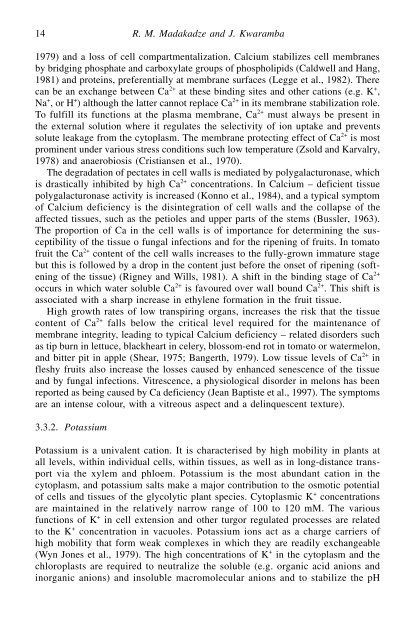Production Practices and Quality Assessment of Food Crops. Vol. 1
Production Practices and Quality Assessment of Food Crops. Vol. 1
Production Practices and Quality Assessment of Food Crops. Vol. 1
Create successful ePaper yourself
Turn your PDF publications into a flip-book with our unique Google optimized e-Paper software.
14 R. M. Madakadze <strong>and</strong> J. Kwaramba<br />
1979) <strong>and</strong> a loss <strong>of</strong> cell compartmentalization. Calcium stabilizes cell membranes<br />
by bridging phosphate <strong>and</strong> carboxylate groups <strong>of</strong> phospholipids (Caldwell <strong>and</strong> Hang,<br />
1981) <strong>and</strong> proteins, preferentially at membrane surfaces (Legge et al., 1982). There<br />
can be an exchange between Ca 2+ at these binding sites <strong>and</strong> other cations (e.g. K + ,<br />
Na + , or H + ) although the latter cannot replace Ca 2+ in its membrane stabilization role.<br />
To fulfill its functions at the plasma membrane, Ca 2+ must always be present in<br />
the external solution where it regulates the selectivity <strong>of</strong> ion uptake <strong>and</strong> prevents<br />
solute leakage from the cytoplasm. The membrane protecting effect <strong>of</strong> Ca 2+ is most<br />
prominent under various stress conditions such low temperature (Zsold <strong>and</strong> Karvalry,<br />
1978) <strong>and</strong> anaerobiosis (Cristiansen et al., 1970).<br />
The degradation <strong>of</strong> pectates in cell walls is mediated by polygalacturonase, which<br />
is drastically inhibited by high Ca 2+ concentrations. In Calcium – deficient tissue<br />
polygalacturonase activity is increased (Konno et al., 1984), <strong>and</strong> a typical symptom<br />
<strong>of</strong> Calcium deficiency is the disintegration <strong>of</strong> cell walls <strong>and</strong> the collapse <strong>of</strong> the<br />
affected tissues, such as the petioles <strong>and</strong> upper parts <strong>of</strong> the stems (Bussler, 1963).<br />
The proportion <strong>of</strong> Ca in the cell walls is <strong>of</strong> importance for determining the susceptibility<br />
<strong>of</strong> the tissue o fungal infections <strong>and</strong> for the ripening <strong>of</strong> fruits. In tomato<br />
fruit the Ca 2+ content <strong>of</strong> the cell walls increases to the fully-grown immature stage<br />
but this is followed by a drop in the content just before the onset <strong>of</strong> ripening (s<strong>of</strong>tening<br />
<strong>of</strong> the tissue) (Rigney <strong>and</strong> Wills, 1981). A shift in the binding stage <strong>of</strong> Ca 2+<br />
occurs in which water soluble Ca 2+ is favoured over wall bound Ca 2+ . This shift is<br />
associated with a sharp increase in ethylene formation in the fruit tissue.<br />
High growth rates <strong>of</strong> low transpiring organs, increases the risk that the tissue<br />
content <strong>of</strong> Ca 2+ falls below the critical level required for the maintenance <strong>of</strong><br />
membrane integrity, leading to typical Calcium deficiency – related disorders such<br />
as tip burn in lettuce, blackheart in celery, blossom-end rot in tomato or watermelon,<br />
<strong>and</strong> bitter pit in apple (Shear, 1975; Bangerth, 1979). Low tissue levels <strong>of</strong> Ca 2+ in<br />
fleshy fruits also increase the losses caused by enhanced senescence <strong>of</strong> the tissue<br />
<strong>and</strong> by fungal infections. Vitrescence, a physiological disorder in melons has been<br />
reported as being caused by Ca deficiency (Jean Baptiste et al., 1997). The symptoms<br />
are an intense colour, with a vitreous aspect <strong>and</strong> a delinquescent texture).<br />
3.3.2. Potassium<br />
Potassium is a univalent cation. It is characterised by high mobility in plants at<br />
all levels, within individual cells, within tissues, as well as in long-distance transport<br />
via the xylem <strong>and</strong> phloem. Potassium is the most abundant cation in the<br />
cytoplasm, <strong>and</strong> potassium salts make a major contribution to the osmotic potential<br />
<strong>of</strong> cells <strong>and</strong> tissues <strong>of</strong> the glycolytic plant species. Cytoplasmic K + concentrations<br />
are maintained in the relatively narrow range <strong>of</strong> 100 to 120 mM. The various<br />
functions <strong>of</strong> K + in cell extension <strong>and</strong> other turgor regulated processes are related<br />
to the K + concentration in vacuoles. Potassium ions act as a charge carriers <strong>of</strong><br />
high mobility that form weak complexes in which they are readily exchangeable<br />
(Wyn Jones et al., 1979). The high concentrations <strong>of</strong> K + in the cytoplasm <strong>and</strong> the<br />
chloroplasts are required to neutralize the soluble (e.g. organic acid anions <strong>and</strong><br />
inorganic anions) <strong>and</strong> insoluble macromolecular anions <strong>and</strong> to stabilize the pH

















